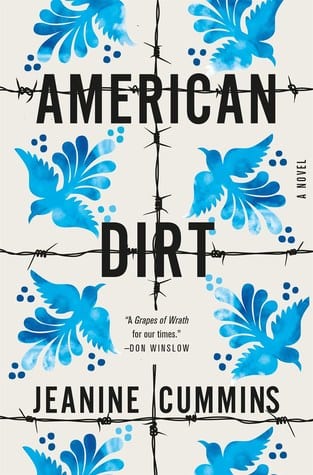I first sat down to read the newest novel by Jeanine Cummins, American Dirt, as usual – in my favorite chair with a cup of coffee. But I’d barely made it through the first chapter when I almost spit a mouth full of coffee out all over my Kindle screen. It wasn’t just that her random italicized words in Spanish made actual Spanish-speaking Mexicans sound like they were speaking a foreign language, or the fact that everyday phrases were treated as exotic slang. It wasn’t even because of the accidental scene in which one character refers to her mother as abuela (the Spanish word for grandma). Rather, it was Cummin’s whole depiction of Mexican life that began evoking recurring feelings of frustration and aversion in me.

The story follows a mother and son, desperately trying to reach the border after their family is slaughtered by a local cartel. But in the midst of this daring journey, they travel through a country that’s more fake than real. It’s a country where the streets feel cold and impersonal; where the people are one-dimensional and clownish; and where the sights and smells seem more bizarre than beloved. Critics have highlighted the inauthenticity of things in this book, like people eating their chicken with BBQ sauce rather than mole, or the depiction of the train, La Bestia. But what stood out to me was the lack of beauty and appreciation for Mexican culture. The protagonists share memories of everything from quinceañeras to family dinners and street vendors, but the descriptions are always short and impersonal. Someone wears a white dress. Abuela’s hair is grey. And that’s about it.
Clearly, this is a novel about Mexicans by a writer who isn’t.
Much of the debate with the fallout of this book has centered on the question of ownership, on whether Jeanine Cummins should have been allowed to write a book about Mexican immigrants, simply because she herself is not Mexican. Cummins herself acknowledges this issue in her author’s note. She writes, “I was worried that, as a nonimmigrant and non-Mexican, I had no business writing a book set entirely in Mexico, set entirely among immigrants. I wished someone slightly browner than me would write it.” Cummins never associated herself as a person of color until writing this book. Now, her Twitter account describes her as an “Irlandaisca Boricua Persona,” a term that makes nods to her grandmother’s Puerto Rican heritage and the fact that her husband is a former undocumented immigrant from Ireland. Cummins is obviously wrestling with her white culture as a writer while also proving that she belongs in this space.
Nevertheless, the question of ethnicity remains at the forefront of the debate for many critics. It’s also led to the social media phenomenon of #ownvoices. The movement was created by Corinne Duyvis as part of a push to encourage diverse storytelling, and since then “own voices” books have become a subset of diverse books that include some type of first-hand experience. In other words, #ownvoices authors share some sort of trait with their protagonists. This is an important conversation. It really is. Because there are real and powerful Latin voices – people like Javier Zamora, Valeria Luiselli, Yuri Herrera, Oscar Martinez, and Myriam Gurba – who are not being heard simply because white publishing houses continue to center white voices when it comes to narratives about immigration and refugees. Cummins received a 7-figure advance for this book, for a book that wasn’t even written that well, and we all now wonder why? We do need to be more careful of who is guiding the narrative.
But this is also where things get a bit tricky. I don’t agree with the rational that writers should only be allowed to write about cultures or people groups they themselves fit into. Largely because these parameters prevent writers – and Christian writers included – from using their pen and their skills to create words in support and solidarity with their fellow humans. To not be able to imaginatively engage with the world around us; to not be able to dream of other possibilities and paths forward; to just stick to your own lane and write about nothing else actually seems close-minded to me. As the British Pakistani writer, Kamila Shamsie once said, “You don’t have to leave the patch of ground on which you live – but it would be helpful if you looked at who else is on that patch of ground with you. To continually return to the same subset of humanity and declare that there is no one else who imaginatively engages you or who you know how to imaginatively engage with, strikes me as one of the most dispiriting things a writer can say.” Is it not through the power of our pen that we can create awareness, highlight both beauty and injustice as well as inspire things like activism and healing?
Honestly, we’re not going to get anywhere if we keep debating the issue of ownership. Which is why I think this should be less a conversation of what cultures you should or shouldn’t be allowed to write about, and instead how to do cross-cultural writing well. How can we center ethnicity, culture, and whole walks of life in our writing in ways that are beautiful, empathetic, and robust? What parameters should we set for ourselves, so that we can write about other cultures without committing offense, violence and/or cultural appropriation? What kind of writing benefits a community and which does not? There is an art to cross-cultural writing, and one that has the power to do so much good.
This is not an impossible ask. It can be done. In fact, it already has been done.
The novel, In the Orchards, the Swallows is a story set in present-day Pakistan, and it follows the life of a 29-year-old man, who returns to the village of his birth after being incarcerated and tortured for 15 years. The novel takes the form of a journal written to the narrator’s beloved, Saba, a girl he hardly knew but the memory of whom has allowed him to remain human in prison. In many ways, this book is a love story, but it’s so much more. Every Pakistani whose read this book praises it for its exquisite language, the beautiful and loving pictures of village life, the poetic descriptions of childhood and nature, and the firm grasp that this novel has on imprisonment in Pakistan.
When I first heard of this book, I naturally assumed that it was written by a Pakistani. Someone who had lived through some of these experiences first-hand. You can imagine my surprise when I learned that this novel was written by a British man named Peter Hobbs! How is it that a white man from a different country could understand Pakistani imprisonment so well? How is it possible for a man who lives in London to understand the beauties and complexities of village life in Northern Pakistan? This book isn’t dripping with colonialism or condescension. Instead, it’s as if Hobbs has intimate knowledge of this place, speaking of it with affection and love.
Obviously, Hobbs creates characters with attributes that he does not own – he’s not writing about his own culture, race or ethnicity, but someone else’s, yet he does it well. He has no interest in peddling stereotypes or viewing Pakistanis through a white male gaze. There is no arrogance or entitlement in his writing, and he is praised for this endeavor, not criticized.
So, what’s the difference? Why did Hobbs succeed where Cummins failed?
Two things stand out. First, Hobbs spent a great deal of time living in Pakistani villages. For over 10 years, he spent time with, observed and researched this people group. He lived like them, received their hospitality and came to understand their way of life. His writing shows true beauty in the world of the Pakistani village. Descriptions of food, trees, and people warm the heart, and these are exactly the types of scenes that Pakistanis felt pride in reading. Second, Hobbs found ways to connect his personal experiences to the characters he creates. During his time in Pakistan, he fell gravely ill and spent at least 5 years of his time there in and out of the hospital. It’s hard not to read Hobbs’ own emergence as a writer from his debilitating illness into the story of a man recovering from 15 years of torture through the composition of a journal. In this way, he hones in on a universal kernel of experience and truth, a love and suffering, and the force of a character shaped by events outside his control.
Cummins also seeks to tap into a universal experience. Her publisher, Flatiron Books, recently tweeted: “When discussing American Dirt, we ultimately go back to the novel’s intention and the way it affects us as readers. American Dirt asks the question, ‘How far will a mother go to protect her son?,’ and in the course of answering that question, gives us empathy with our fellow human beings who are struggling to find safety in our unsafe world. This is the lens through which we have viewed American Dirt as the publisher, and the way in which we hope it can be appreciated by readers.”
It was a noble task. I’ll grant Cummins that. But what ultimately led to her book’s plummeting credibility is its inability to achieve authenticity and compassion. This is a skill that requires research. It requires studying a place, interviewing people, and possibly even living there yourself. Author, Chris Cleave says, “I do my research. Sometimes – as when interviewing refugees and torture survivors – I’ve learned things I wish I could unlearn. The violence of the world’s true stories can crack you open. You lose the shape you were molded in. You take on other forms.” Cummins, however, did none of this. Instead, she interpreted a real-life situation in Mexico through her privileged white cultural lens. Even worse, she tried to borrow inspiration and scenes from established Mexican writers, like Luis Alberto Urrea’s By the Lake of Sleeping Children and Sonia Nazario’s Enrique’s Journey. Plagiarism took the seat of authenticity, and borrowed ideas replaced any attempt at originality.
The thing is, when you write like that, nobody benefits. Mexican immigrants can’t read this story and feel like their lives are reflected in it. White Americans can’t read it and gain a sense of how they should better love and care for their immigrant neighbors. This book profited no one, except perhaps Cummins herself and her 7-figure advance.
All we’re left with is to wonder what other forms Cummins’ book could have taken, and the challenge for the rest of us, as writers and as readers, is to do better. When it comes to cross-cultural writing, we must both write compassionately and read critically if we’re going to have any hope of paving a new path forward.













